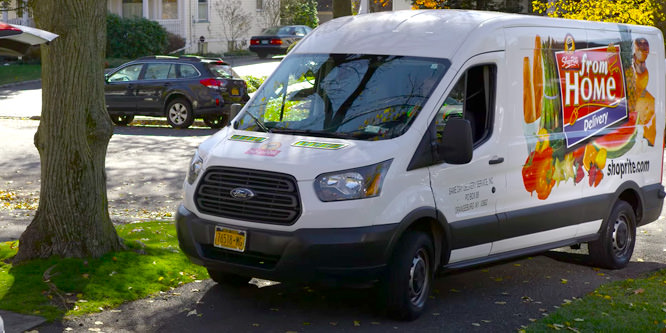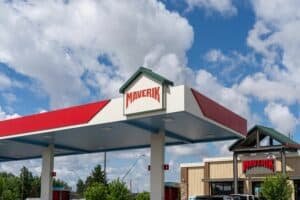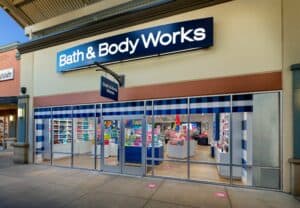
Source: ShopRite ad
February 1, 2017
How will online shopping transform the grocery business?
A new report from the Food Marketing Institute and Nielsen projects that consumer spending for online grocery shopping could reach as much as $100 billion or 20 percent of total dollar grocery purchases made by consumers by 2025. Those figures, the parties report, are the equivalent of 3,000 grocery stores based on volume.
The research, according to a CNBC report, puts the current market share of online sales at 4.3 percent of total spending for food and beverages. Using their most conservative projection, online grocery sales would roughly double by 2025.
A wide variety of companies from brick and mortar retail (Kroger, ShopRite, Walmart, et al) as well as online (Amazon.com, Door to Door Organics, FreshDirect, et al) are today offering Americans the option of home delivery or store pickup for grocery orders. Companies ranging from Costco to Whole Foods are working with third parties to enable home delivery.
Today, according to the research findings, 23 percent of U.S. households are buying food online. Among these, 60 percent expect to spend over a quarter of their food dollars online.
Younger and more digitally-engaged consumers who have yet to become regular grocery shoppers will help drive further adoption in the years to come.
Center store products representing 40 percent of the segment’s volume are expected to migrate online.
In a press release to announce the report, executives spoke of the grocery industry being at “a tipping point” and of the window to respond “narrowing” for food retailers and their suppliers.
One of the biggest challenges facing grocers is the matter of profitability, a point of frustration going back to Streamline and Webvan in the early days of online grocery. Many believe that store pickup is the key to achieving profitability in the notoriously tight margin grocery business.
- FMI and Nielsen Release First Set of Findings on the Digitally Engaged food Shopper – Nielsen/Food Marketing Institute
- The Digitally Engaged Shopper – Nielsen/Food Marketing Institute
- Online grocery sales set to surge, grabbing 20 percent of market by 2025 – CNBC
- Will Online Grocery Sales Cripple Kroger and Safeway? – 24/7 Wall St./Yahoo! Finance
Discussion Questions
DISCUSSION QUESTIONS: Do you see online grocery adoption reaching a tipping point soon? What effects do you think online sales will have on physical grocery stores between now and 2025?
Poll
BrainTrust
Nikki Baird
VP of Strategy, Aptos
Recent Discussions







This is THE topic in grocery today! And this is the money stat/quote:
“Amazon spends more on innovation than the twenty largest supermarket companies in America combined. If retailers don’t start investing at a greater level of innovation, they’re going to become lunch served for Amazon.” — Jerry Sheldon, retail analyst with IHL Group.
So the first step is that grocery chains must take action. Once they do, physical stores are likely to change accordingly over the next few years. My predictions for the coming few years are (evolution, not revolution):
And of course stores that ignore the growing consumer demand for e-commerce, or leave it to Amazon to satisfy that demand, will start to fall by the wayside.
Jon,
Thanks for saving me a lot of typing on my phone this morning. You nailed it.
Personally, I’ve been waiting for this for a while. Grocers lag pretty much every other sector in retail in terms of embracing online shopping. I think they have been too complacent. Once someone (ahem, Amazon perhaps?) figures out the business model, I think this will go much faster than we’ve seen in other verticals, if only because consumers ARE already trained in online shopping. There is some pain for the shopper in moving your grocery list online, but once you’ve done that, it becomes a maintenance exercise. I can see a future where grocery stores are 80 percent fresh, 20 percent shelf-stable and impulse, and a big warehouse section for either home delivery or curb-side pickup. And that’s definitely not how grocery stores look today, which means the transition will be painful.
People buy groceries online for the convenience. They get what they want, when they want it, without having to visit a store and they are willing to pay a bit more for it. Grocers take heed, your stores make shopping difficult. The aisles are crammed with stand-alone displays, stores are difficult to navigate, there are too many line extensions cluttering the shelves, checkout takes too long, non-food items are too expensive compared to Amazon and it’s hard to find assistance. Time-starved consumers would rather shop online and have orders delivered. Grocery stores need to adapt or watch their business migrate elsewhere. Emphasis should be placed on speed, efficiency and in-store experience or grocers risk more than 10 percent of business migrating online by 2025. And making consumers come to the store to pick up orders is not the answer.
We should keep in mind that Nielsen has been projecting very high numbers for years – they simply keep pushing out the timeline of when we’ll hit those high numbers. There’s your grain of salt.
True, but … Amazon is now proving to be as serious as ever about figuring out e-grocery. I wouldn’t bet against them and, if I were a grocery chain, I wouldn’t watch idly as they figure it out.
But adoption is generally a slow roll, then an acceleration. If not 20 percent by 2025, I predict 50 percent by 2030. The real question to ask, with what online grocery can offer, is not “why?” but “why not?”
The adoption of online food sales has a lot to do with a factor we discussed yesterday. Haptic technology needs to address other human senses beyond sight. People want to touch, smell, etc. food. Online grocery shopping has been around for literally 30 years. The market will adopt this service widely over time, however we are still easily five years away from the true tipping point away from in-store shopping … if ever.
Where online orders suit grocery refreshment, in-store visits will suit discovery of alternate or new products and will be an outing for those who enjoy the tactile experience. For both reasons, grocery retail can compete more successfully by taking their customer experience to the next level. Providing information during product selection and cross-selling serves all interests.
The trend will continue because retailers will make it easier for consumers to shop for groceries online. The impact of increased online grocery shopping will be the same as it has proven to be for hard goods and apparel, albeit maybe to a lesser extent. That is, that store’s footprint will have to decrease commensurately with the increase of online ordering or grocers will have to experiment with other products or services to fill the unneeded space.
Between restaurant delivery (GrubHub, Uber EATS, et.al.), meal kit delivery (like Blue Apron) and dry goods grocery delivery, there won’t be much reason to “shop” the grocery store any more, except fresh. And for that we have farmers’ markets and fresh delivery. Grocery needs to find a role in the future of meal solutions and home replenishment shopping. I believe that grocery needs to really corner the market on grab-and-go, grocerant-style food with some fill-in dry goods categories.
Today, many households need two incomes to enjoy the lifestyle they want to have and so I do see online shopping for groceries reaching the tipping point sooner than later. We will continue to see smaller chains either sell out or disappear and it will be a survival of the fittest. The industry will adjust as it did to the advent of c-stores, super centers, dollar stores and even in response to the rise of quick-serve restaurants. It will be better but smaller with chains such as Kroger, Publix, Albertsons, Wegmans and Whole Foods doing well.
This is shaping up to be a 25-year overnight success. Among physical shopping, grocery has always been more of a hassle than a source of delight, so what is now finally an internet-savvy (at least comfortable) society will surely embrace the convenience. Plus most Americans still eat the SAD (Standard American Diet), choosing commercial brands that they are familiar with. So without an interest in carefully scrutinizing labels or picking fresh food items, it’s a big time saver.
Our family eats very differently than the majority so hand-selecting fresh organic fruits and vegetables is paramount, but for packaged items, like pasta, we buy online and take the savings and doorstep delivery convenience. And no, Amazon is NOT competitive with other merchants on these items.
As we Baby Boomers continue to age, we will begin to use online grocery shopping more and more. Although we’re not digital natives, we’ve become digitally aware and can use the tools more readily. As more seniors stay in their homes longer the need for these services will increase, particularly for those of us that live in the northern latitudes (Minneapolis in my case). The winters — never mind the temperatures — have an impact on traveling conditions and having groceries delivered will continue to be embraced.
Grocery is retail. The shift of brick-and-mortar retailers (not including grocery) doing more business online is the norm. They are figuring out the balance on how to change their distribution system, stock properly and more. Grocery should take a lesson from the retailers in other industries to learn how they have adapted to the new way the consumer likes to shop.
Since I am not a grocery shopper I should probably stay away from this but … I have always thought that staples would be the hot market for e-commerce. Those things that you buy regularly and can predict when you will be out. Many staples are groceries. So grocery is long overdue to jump on the e-commerce bandwagon. With Amazon in the mix, things are going to stir up quick!
For my 2 cents.
“Lies, damn lies and statistics,” said Mark Twain, and he is very correct. Online grocery shopping is a solution looking for a problem. Grocery retailing survives on very thin margins, the appeal of personally choosing fresh fruit, vegetables, meats, etc. Plus the local grocery store is a destination location for community, chat and discovery. Go into any great grocer like Whole Foods or Trader Joe’s and you will see this thriving. Replacing this from a business perspective will be difficult to say the least and certainly not profitable.
Agreed! While there is a trend towards delivery and online shopping replacing mundane errands, grocery-shopping is a pleasure for many people. Do you think there will be some pushback from stores like Trader Joe’s or Whole Foods making shopping even more of an experience (with coffee/wine tastings, cooking classes, etc)? Or will consumers combine the two — delivery for boring standard necessities, and that saved time spent enjoying the experience of a farmers’ market or shopping for the perfect gourmet cheese?
All those projected sales are always stated way out into the future. Online shopping still isn’t practical. I’ve seen it work well for people in remote locations like Lanai or Molokai, rural Alaska, etc. But for people with cars, grocery shopping is fun and people like doing it themselves. If it’s not fun, you are not going to the right store.
Sorry David, I live in NYC and except for trips to Whole Foods for specific purchases all our grocery shopping is online, as it is for my son’s and daughter’s families (they showed us the way). In my building, only Amazon beats Fresh Direct with number of delivers per day.
Gene, I really think you are an outlier in terms of the percentage of shopping you do online. I am, too, but where shoppers have access to supermarkets and other grocery stores like Publix, Trader Joe’s, and Whole Foods and are in areas where service is good, most folks still like to get out of the house and pick their own groceries, especially fresh items.
I should have clarified: for people who are living in urban areas where it is impractical to own a car, online shopping is a good option. Or for people who can no longer drive.
Maybe not a tipping point but the wave is washing ashore and, to-date, grocery retailers have been slow to respond. It is similar to the predictions that have been made over the last few years with still little pro-active omnichannel planning in process by brick-and-mortar retailers.
The FMI/Nielsen report forecasts that a significant number of brick-and-mortar categories, representing 40 percent of center store volume, will migrate to an online shopping experience. This prediction is sobering and its fruition will have serious deleterious effects on physical grocery stores in the not-so-distant future.
Online shopping will have a major impact on the grocery business: Amazon Dash is showing how repeat purchases of routine items are being put on auto-pilot. Auto-replenishment could have a striking impact on the center of the store and lead it to shrink dramatically. The question is, what will grocers do with the space that becomes available when center store categories shrink? In some locations they will expand the fresh areas of the store, in others they will introduce more experience-based elements into their stores; some will use the space to fulfill online orders; some will simply reduce the size of their stores and move fulfillment of online orders to cheaper warehouse-like locations.
The grocery store will not vanish completely as some shoppers will still want/need to go to the store for some purchases, but the size/layout of the stores and the prevalence of them will be impacted by online grocery shopping. We also have to remember that many shoppers only start thinking about the evening family meal during the day and they visit the store on the way home from work to purchase the elements required for the meal. While grocery delivery, click-and-collect or online ingredient companies can fulfill some of these needs it will be interesting to see if the short-term planning of some shoppers can be truly satisfied by any means other than by visiting a store.
There are still a few areas that need to be addressed before grocery e-commerce can fulfill its potential and profitability is certainly a key issue. The expense of setting up a delivery system is high but it would be more expensive to simply lose sales to others who are satisfying shopper needs by providing an e-commerce offering. Click-and-collect is one solution and that option will appeal to a significant subset of online shoppers — it also overcomes one of the major challenges with home delivery, namely the need to be at home when the delivery arrives. Grocers need to address the profitability issue with home delivery as a number of shoppers are going to want that as an e-commerce option. They will also need to ensure they overcome the inconvenience of having to stay at home by providing very narrow delivery windows at times when shoppers are more likely to be at home (e.g., in the evenings). Some grocery stores that provide home delivery are addressing this issue by differential pricing for different delivery times and delivery window lengths — we will see more of these types of approaches. Other grocers are looking to provide more personalized offers to online shoppers in an attempt to capture a greater share of the shopper’s spend — this drives up the sales per delivery and can have a very attractive impact on the profitability of a home delivery order.
I started in the grocery business 29 years ago and I have been hearing about home delivery making an impact on sales ever since. It requires high population densities to make any kind of sense. Many have tried and failed in the past. Maybe the time is approaching but I don’t see it as a big threat before I reach retirement age.
Online grocery shopping will grow for sure, but the problem I see is profitability. I already deal with the fact that the big box stores and the national chains are getting better costs on key staple items, which has caused me to rethink how I run my store. Now with online growing, it could be the final nail in the coffin for stores that are currently struggling — and there are many, including me.
The major cities and suburbs will do very well with online ordering, as paying more for this service is not a big problem. However, how much more are the rest of the folks willing to pay in higher prices to have their food delivered? It simply cannot be free, as the costs to procure the product and get it to someone’s home cannot cost the same as a supermarket, unless I’m wrong, which is possible. I can see staple goods being quite competitive, but perishable food must be delivered safely and it takes a very expensive vehicle to do that, and a pound of ground chuck could be $5 per pound, along with deli and prepared foods costing more as well.
I agree with some of the comments about scaling down with more space devoted to perishables, as I already have done. Is it enough to stay in business? We will have to see how this all unfolds, but there will be heavy casualties over time and jobs lost in the smaller towns. This is the cost of moving forward. Turning back the clock to the good old days where the local store owner and other small shops were the gathering places for the folks, and they supported the little league teams and local events will be impossible, much to the chagrin of the folks who are left with fewer choices and no one to sponsor their events. That is kind of sad, but consumers ultimately decide with their pocketbooks and e-commerce will win out. Lucky for me I’m looking forward to sticking around as long as I can, with grown kids who can adapt to whatever happens and I wish all the younger generation of store owners well, and hopefully they can change how they are currently doing things to be successful.
I don’t believe online grocery shopping is headed for a tipping point — at least outside dense urban areas — and here’s why:
Amazon is opening 2000 physical grocery stores now and I believe that’s because they don’t believe online has a tipping point coming either.
There will be factors that improve online grocery, especially for major urban hubs, but I think that most people who are going outside regularly (say to a school, job or on other errands) will continue to stop by a grocery store one a week. Grocery’s going to be the last store people stop visiting — more likely you pick up your other online shopping while you browse produce at the grocery store in person. Plus, the main complaint about grocery stores (waiting in line) will be a distant memory in a few years.
Is there room in grocery margin to withstand the cost of home delivery? Will the consumer pay for the service of home delivery? At this point it’s a convenience play for urban and high-income consumers. Convenience has a cost and grocery many not be able to brunt the cost without going into the red.
Two decades ago I latched onto the trend story about online grocery ordering and home delivery from companies like Streamline (defunct) and Peapod (still surviving). I observed then that if 20% of shoppers used such services 25% of the time it would skim 5% of grocery trips off the top, while adding operational complexity and creating new price transparency. I boldly predicted it would take less than 5 years to achieve this impact.
Well, as Ken sagely observes, online grocery sales has been a slow-motion overnight success story. Shoppers didn’t change their habits overnight. They have been enmeshed in the world’s largest test-and-learn experience, as innovators keep experimenting with new methods of digital merchandising, promotion and order fulfillment.
To reach 20% penetration by 2025, as the FMI/Nielsen report boldly predicts, 40% of households will need to purchase groceries online 50% of the time. The present figures cited above (at 23% of U.S. households, 60% spend 25%) works out to about a 4% share, so there’s a long road yet to travel.
What we see happening is hardly a tipping point. It’s the continuation of a gradual, inexorable displacement of grocery shopping habits, owing to a plethora of FMCG purchasing alternatives that range from Dash buttons to meal kit services to full-basket home delivery to click-and-collect.
In response, we are witnessing the necessary evolution of the brick-and-mortar supermarket from a center-store-weighted concept that used to be focused on frequently-replenished packaged goods to a perimeter-weighted concept increasingly focused on fresh and prepared foods.
I’m ready to make one more bold prediction, here and now: Most households will still be shopping in grocery stores most of the time in 2025 and we RW BrainTrusters will still be analyzing reports of this “sudden” market shift.
23%x60%x25% = 3% … that’s a long ways from 20%. Admittedly this is just a lower bound, but I think it’s a lot closer to what’s going to happen. And statements like “one of the biggest challenges is profitability” only add to that belief.
I absolutely believe that online grocery spending increases are already starting in two ways: dry groceries and replenishables, and prepared food/food for delivery. It’s just a matter of time before the rest of the basket gets filled in by a smart retailer.
Trying to predict the future is risky at best. However if the penetration level reaches 20 percent I feel that center store will be much higher as a percentage of that number. What does that mean for retailers? It could mean even smaller center store departments, fewer items and less variety stocked at retail, centralized pickup points for customers, etc. Conversely fresh departments might be more important to consumers so store configuration and maybe total size will evolve. Unfortunately many retailers have been building bigger and bigger stores. They may have to rethink the footprint model.
From personal experience, once you’ve done it, you’re hooked. The time savings and efficiency of replenishment product purchasing makes choosing to buy groceries online a no-brainer. Young families no longer have time or patience for two-hour weekly escapades to the grocer, the elderly and infirm don’t have to brave the weather, busy worker bees and professionals can streamline a “task” of meal preparation. Once the difficult operational model is figured out, then adoption will rise. It doesn’t matter how long online grocery has been available. Once the influencers get the word out, we’ll see tremendous growth, and that time is coming.
Regarding the shopping experience, people who do the bulk of grocery shopping online now take a much more relaxed, pleasurable trip to the grocery store weekly to hand-pick fruits and vegetables. Instead of being in a hurry, they stroll through the aisles and tend to look at displays and items they might not have noticed in previous frenzied trips to get everything. Yes, the dynamics of shopping will change and the physical footprint of stores will get smaller to make room for the pick and packing, but that tipping point is soon to come.